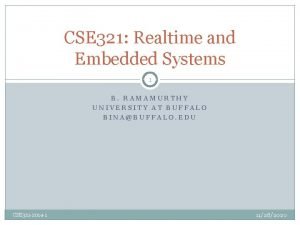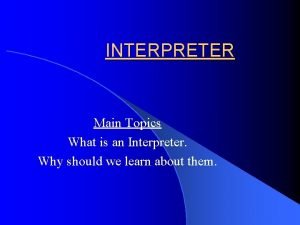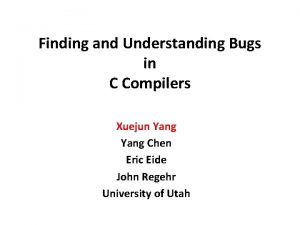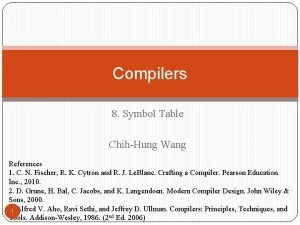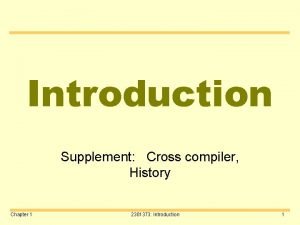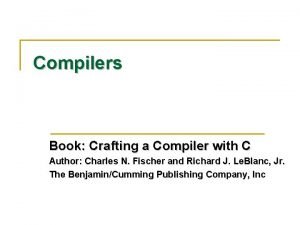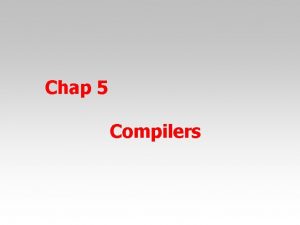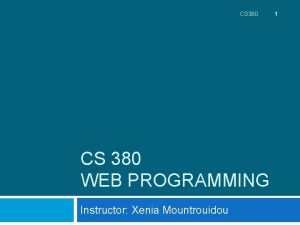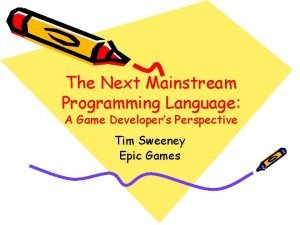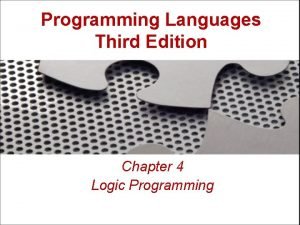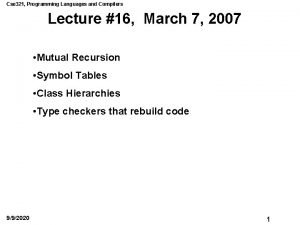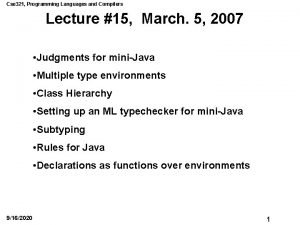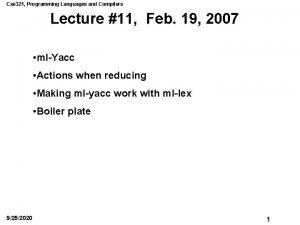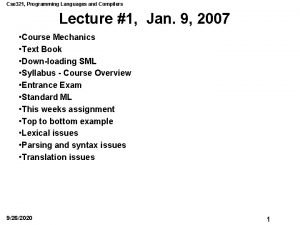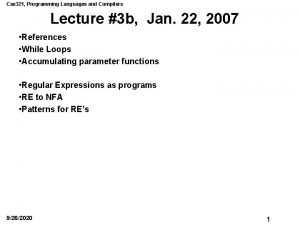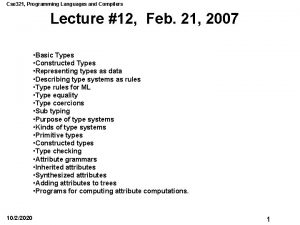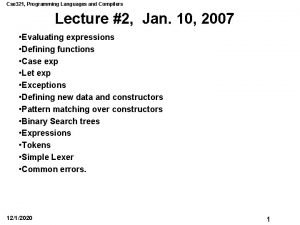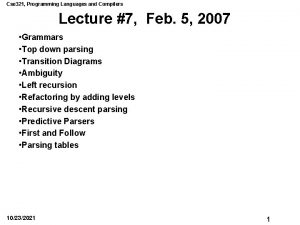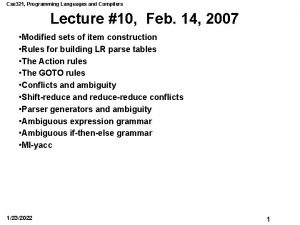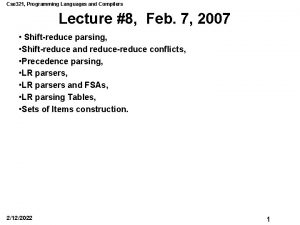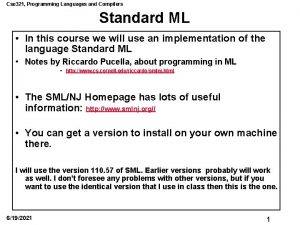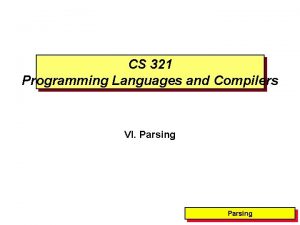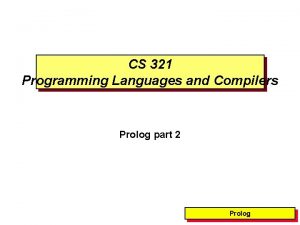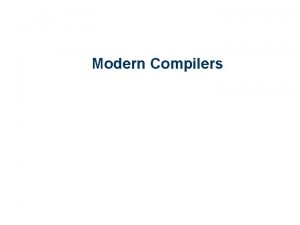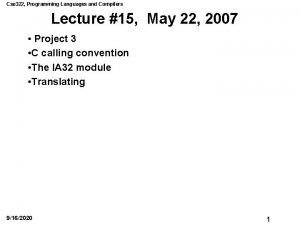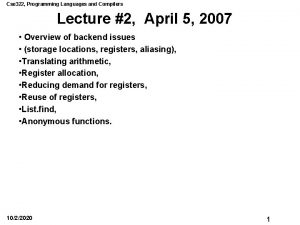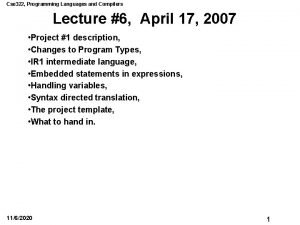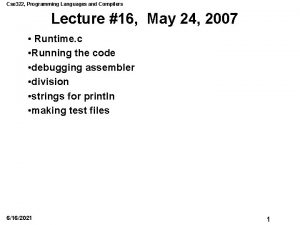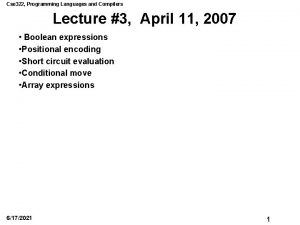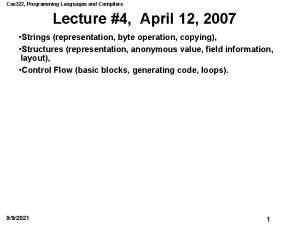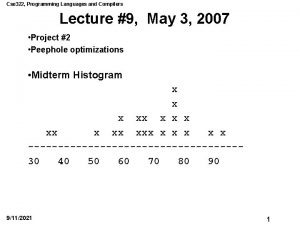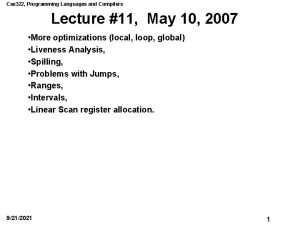Cse 321 Programming Languages and Compilers Lecture 4


![Cse 321, Programming Languages and Compilers Homework 3 fun reverse [] = [] | Cse 321, Programming Languages and Compilers Homework 3 fun reverse [] = [] |](https://slidetodoc.com/presentation_image_h2/9acb24261223a3f1bff808267d84e415/image-3.jpg)








![Cse 321, Programming Languages and Compilers ML code fun inner. While x [] ans Cse 321, Programming Languages and Compilers ML code fun inner. While x [] ans](https://slidetodoc.com/presentation_image_h2/9acb24261223a3f1bff808267d84e415/image-12.jpg)


















- Slides: 30

Cse 321, Programming Languages and Compilers Lecture #4, Jan. 24, 2007 • Homework 3 • Representing sets as lists • the cross product of two sets • epsilon transitions • epsilon - closure • Interpreting an NFA • NFA to DFA Labs scheduled: 1/31/2022 Thursday 4: 00 pm, Friday at 9: 00 am 1

Cse 321, Programming Languages and Compilers Assignments • Read Chapter 2, pages 27 -72 – There will be a 5 minute quiz next lecture • Programming exercise 4 is listed on the web page. It is due next Monday. – exercise writing accumulating parameter functions – a guided exercise to write the e-closure in 10 easy steps 1/31/2022 2
![Cse 321 Programming Languages and Compilers Homework 3 fun reverse Cse 321, Programming Languages and Compilers Homework 3 fun reverse [] = [] |](https://slidetodoc.com/presentation_image_h2/9acb24261223a3f1bff808267d84e415/image-3.jpg)
Cse 321, Programming Languages and Compilers Homework 3 fun reverse [] = [] | reverse (x: : xs) = reverse xs @ [x]; fun reverse 2 xs = let fun revonto [] ans = ans | revonto (x: : xs) ans = revonto xs (x: : ans) in revonto xs [] end; fun count n [] = 0 | count n (x: : xs) = if n=x then 1 + count n xs else count n xs; fun concatenate [] = [] | concatenate (xs: : xss) = xs @ concatenate xss; 1/31/2022 3

Cse 321, Programming Languages and Compilers Fully Parenthesized fun | | and to. Str Empty = "#" to. Str (C c) = implode [c] to. Str (Concat(x, y)) = to. Str. P x ^ to. Str. P y to. Str (Union(x, y)) = to. Str. P x ^"+"^to. Str. P y to. Str (Star x) = to. Str. P x ^ "*" to. Str. P x = "("^to. Str x^")"; - to. Str re 1; val it = "((+)+((-)+(#)))((D)*))" : string 1/31/2022 4

Cse 321, Programming Languages and Compilers Not parenthesizing leaf REs fun | | and | | to. Str 2 Empty = "#" to. Str 2 (C c) = implode [c] to. Str 2 (Concat(x, y)) = to. Str 2 P x ^ to. Str 2 P y to. Str 2 (Union(x, y)) = to. Str 2 P x ^"+"^to. Str 2 P y to. Str 2 (Star x) = to. Str 2 P x ^ "*" to. Str 2 P (x as (C _)) = to. Str 2 x to. Str 2 P (x as Empty) = to. Str 2 x to. Str 2 P x = "("^to. Str 2 x^")"; - to. Str 2 re 1; val it = "(++(-+#))(D(D*))" : string 1/31/2022 5

Cse 321, Programming Languages and Compilers Escaping special characters fun | | escape escape #"+" = "\+" #"*" = "\*" #"(" = "\(" #")" = "\)" c = implode [c]; fun | | and | | to. Str 3 Empty = "#" to. Str 3 (C c) = escape c to. Str 3 (Concat(x, y)) = to. Str 3 P x ^ to. Str 3 P y to. Str 3 (Union(x, y)) = to. Str 3 P x ^"+"^to. Str 3 P y to. Str 3 (Star x) = to. Str 3 P x ^ "*" to. Str 3 P (x as (C _)) = to. Str 3 x to. Str 3 P (x as Empty) = to. Str 3 x to. Str 3 P x = "("^to. Str 3 x^")"; - to. Str 3 re 1; val it = "(\++(-+#))(D(D*))" : string 1/31/2022 6

Cse 321, Programming Languages and Compilers A separate rule for each sub-RE fun | | | | and | | to. Str 4 to. Str. C to. Str. U to. Str. S Empty = "#" (C c) = escape c (Concat(x, y)) = to. Str. C x ^ to. Str. C y (Union(x, y)) = to. Str. U x ^"+"^to. Str. U y (Star x) = to. Str. S x ^ "*" (x as (C _)) = to. Str 4 x (x as Empty) = to. Str 4 x (x as (Concat _)) = to. Str 4 x (x as (Star _)) = to. Str 4 x x = "("^to. Str 4 x^")" (x as (C _)) = to. Str 4 x (x as Empty) = to. Str 4 x (x as (Union _)) = to. Str 4 x x = "("^to. Str 4 x^")" (x as (C _)) = to. Str 4 x (x as Empty) = to. Str 4 x x = "("^to. Str 4 x^")"; - to. Str 4 re 1; val it = "(\++-+#)DD*" : string 1/31/2022 7

Cse 321, Programming Languages and Compilers Representing Sets in ML • We do it for ‘int’ others would be similar • Key – Represent a set as an ordered list without duplicates fun mem x [] = false | mem x (y: : ys) = if x=y then true else mem x ys; datatype order = EQUAL | LESS | GREATER; fun set. Add x [] = [x] Note the use of the Int library compare function. | set. Add x (y: : ys) = case Int. compare (x, y) of EQUAL => (y: : ys) | LESS => x: : ys | GREATER => y : : set. Add x ys; 1/31/2022 8

Cse 321, Programming Languages and Compilers Union of two sets • Take advantage of the fact that the lists are ordered, this allows union with time proportional to what? fun | | | set. Union [] [] = [] set. Union [] ys = ys set. Union xs [] = xs set. Union (x: : xs) (y: : ys) = case Int. compare (x, y) of EQUAL => set. Union xs (y: : ys) | LESS => x: : set. Union xs (y: : ys) | GREATER => y : : set. Union (x: : xs) ys; fun set. Concat [] = [] | set. Concat (x: : xs) = set. Union x (set. Concat xs); 1/31/2022 9

Cse 321, Programming Languages and Compilers Can we turn a normal list into a set? (* Turn a list into a set *) (* sort and remove duplicates. *) fun sort [] = [] | sort (x: : xs) = set. Add x (sort xs); fun rem. Dup. From. Ordered [] = [] | rem. Dup. From. Ordered [x] = [x] | rem. Dup. From. Ordered (x: : y: : zs) = if x=y then rem. Dup. From. Ordered (y: : zs) else x: : rem. Dup. From. Ordered (y: : zs); fun norm xs = rem. Dup. From. Ordered(sort xs); 1/31/2022 10

Cse 321, Programming Languages and Compilers Cross Product • Consider the two sets – [1, 2, 6] – [3, 5] • The cross product is a set of pairs – all possible pairs (x, y) where x comes from [1, 2, 6] and y comes from [3, 5] – [(1, 3), (1, 5), (2, 3), (2, 5), (6, 3), (6, 5)] • How could we compute this? In pseudo code ( ans : = [ ] ; while not (null xs) do let val x = hd xs val ptr = y in while not (null ptr) do let val y = hd ptr in ans : = (x, y): : ans ptr : = tl ptr end; xs : = tl xs end) 1/31/2022 This has the pattern of a nested set of accumulating parameter functions! 11
![Cse 321 Programming Languages and Compilers ML code fun inner While x ans Cse 321, Programming Languages and Compilers ML code fun inner. While x [] ans](https://slidetodoc.com/presentation_image_h2/9acb24261223a3f1bff808267d84e415/image-12.jpg)
Cse 321, Programming Languages and Compilers ML code fun inner. While x [] ans = ans | inner. While x (y: : ys) ans = inner. While x ys ((x, y): : ans) ; fun outer. While ys [] ans = ans | outer. While ys (x: : xs) ans = outer. While ys xs (inner. While x ys ans); fun cross xs ys = outer. While ys xs []; 1/31/2022 ( ans : = [ ] ; while not (null xs) do let val x = hd xs in while not (null ys) do let val y = hd ys in ans : = (x, y): : ans xs : = tl xs ys : = tl ys end) 12

Cse 321, Programming Languages and Compilers The power of a set of strings if A = [“x”, “y”] what is AA, or AAAA fun power 0 x = [""] | power n x = map (op ^) (cross x (power (n-1) x)); power 3 ["a", "xy"]; Val it = ["xyaxy", "xyaa", "xyxyxy", "xyxya“ , "aaxy", "aaa", "axyxy", "axya"] 1/31/2022 13

Cse 321, Programming Languages and Compilers Concat(Union(C #”+”, Union(C #”-”, Empty)) , Concat(C #”D”, Star (C #”D”))) (+|-| ε)DD* ε + 0 1 ε 8 val ex 6 = ε (8, 15, ε [Edge (9, Epsilon, 10) 6 , Edge (8, Epsilon, 0) , Edge (8, Epsilon, 6) ε , Edge (1, Epsilon, 9) , Edge (7, Epsilon, 9) , Edge (0, Char #"+", 1) , Edge (6, Epsilon, 2) , Edge (6, Epsilon, 4) , Edge (3, Epsilon, 7) , Edge (5, Epsilon, 7) , Edge (2, Char #"-", 3) , Edge (4, Epsilon, 5) , Edge (11, Epsilon, 14) , Edge (10, Char #"D", 11) , Edge (14, Epsilon, 12) , Edge (13, Epsilon, 15) , Edge (14, Epsilon, 15) , Edge (15, Epsilon, 14) , Edge (12, Char #"D", 13)]) : Nfa 1/31/2022 2 4 ε 9 3 5 ε ε ε 10 D 7 11 ε 14 ε 12 ε D 13 ε 15 14 ε

Cse 321, Programming Languages and Compilers Epsilon transitions + 0 ε 1 ε 8 ε 2 ε - 6 ε 4 ε 9 3 5 ε ε • Note that in state 8, one can get to {0, 6, 2, 4, 5, 7, 9, 10} by not consuming any characters. • We need only take epsilon transitions • This set is called the epsilon-closure 1/31/2022 10 D 7 11 ε 14 ε 12 ε D 13 – eclosure [8] = {0, 6, 2, 4, 5, 7, 9, 10} • How do we compute this? ε ε 15 15 ε

Cse 321, Programming Languages and Compilers 1 -step epsilon + 0 ε 1 ε 8 ε 2 ε - 6 ε 4 ε 9 3 5 • Note that every state has a 1 -step epsilon set. many states have empty • one. Step 8 = [0, 6] epsilon sets • one. Step 0 = [ ] • one. Step 4 = [5] • one. Step 6 = [2, 4] • . . . 1/31/2022 ε ε ε 10 D 7 11 ε 14 ε 12 ε D 13 ε 15 16 ε

Cse 321, Programming Languages and Compilers Recall how an NFA is represented val ex 6 = (8, 15, [Edge (9, Epsilon, 10) , Edge (8, Epsilon, 6) , Edge (1, Epsilon, 9) , Edge (7, Epsilon, 9) , Edge (0, Char #"+", 1) , Edge (6, Epsilon, 2) , Edge (6, Epsilon, 4) , Edge (3, Epsilon, 7) , Edge (5, Epsilon, 7) , Edge (2, Char #"-", 3) , Edge (4, Epsilon, 5) , Edge (11, Epsilon, 14) , Edge (10, Char #"D", 11) , Edge (14, Epsilon, 12) , Edge (13, Epsilon, 15) , Edge (14, Epsilon, 15) , Edge (15, Epsilon, 14) , Edge (12, Char #"D", 13)]) 1/31/2022 fun one. Step n (Edge(s, Epsilon, f)) = if n=s then [f] else [] | one. Step n (Edge(s, Char _, f)) = [] • Given a list of edges we apply this function to every edge. fun one. Step. From. Edges es n = set. Concat(map (one. Step n) es); • How does this work? 17

Cse 321, Programming Languages and Compilers Step – by - step val edges = [Edge (9, Epsilon, 10) , Edge (8, Epsilon, 6) , Edge (1, Epsilon, 9) , Edge (7, Epsilon, 9) , Edge (0, Char #"+", 1) , Edge (6, Epsilon, 2) , Edge (6, Epsilon, 4)] - one. Step 8 (Edge(5, Epsilon, 6)); val it = [ ] - one. Step 8 (Edge(8, Epsilon, 6)); val it = [6] we only get output if the start state matches n fun one. Step. From. Edges n es = List. concat (map (one. Step n) es); - map (one. Step 8) edges; val it = [[], [0], [6], [], [], []] - set. Concat [[], [0], [6], [], [], []]; val it = [0, 6] : int list 1/31/2022 18

Cse 321, Programming Languages and Compilers One step from a set of states • Note one. Step. From. Edge only gives the e-states from a single starting state. • What if I wanted all the reachable states on epsilon from both 8 or 9? 10 + 0 ε D 1 ε ε ε 8 ε 2 ε - 6 ε 4 ε 14 9 3 5 ε ε ε 11 7 ε 12 D 13 ε fun one. Step. From. Set es states = set. Concat (map (one. Step. From. Edges es) states); 15 1/31/2022 19 ε

Cse 321, Programming Languages and Compilers Iterate fun one. Step. From. Set es states = set. Concat (map (one. Step. From. Edges es) states); - one. Step. From. Set edges [8]; val it = [0, 6] : int list - one. Step. From. Set edges (set. Union [8] [0, 6]); val it = [0, 2, 4, 6] : int list - one. Step. From. Set edges (set. Union [0, 6, 8] [0, 2, 4, 6]); val it = [0, 2, 4, 5, 6] : int list - one. Step. From. Set edges (set. Union [0, 2, 4, 6, 8] [0, 2, 4, 5, 6]); val it = [0, 2, 4, 5, 6, 7] : int list - one. Step. From. Set edges (set. Union [0, 2, 4, 5, 6, 8] [0, 2, 4, 5, 6, 7]); val it = [0, 2, 4, 5, 6, 7, 9] : int list - one. Step. From. Set edges (set. Union [0, 2, 4, 5, 6, 7, 8] [0, 2, 4, 5, 6, 7, 9]); val it = [0, 2, 4, 5, 6, 7, 9, 10] : int list - one. Step. From. Set edges (set. Union [0, 2, 4, 5, 6, 7, 8, 9] [0, 2, 4, 5, 6, 7, 9, 10]); val it = [0, 2, 4, 5, 6, 7, 9, 10] : int list 1/31/2022 20

Cse 321, Programming Languages and Compilers eclose fun eclose edges states = let val new = one. Step. From. Set edges states val union = set. Union new states in if union = states then states else ( print (set. To. String states) ; print (set. To. String new) ; print (set. To. String union) ; print "-------n" ; eclose edges union ) end; 1/31/2022 - eclose edges [8]; [8] [0, 6, 8] -----------[0, 6, 8] [0, 2, 4, 6, 8] -----------[0, 2, 4, 6, 8] [0, 2, 4, 5, 6, 8] -----------[0, 2, 4, 5, 6, 8] [0, 2, 4, 5, 6, 7, 8] -----------[0, 2, 4, 5, 6, 7, 8] [0, 2, 4, 5, 6, 7, 9] [0, 2, 4, 5, 6, 7, 8, 9] -----------[0, 2, 4, 5, 6, 7, 8, 9] [0, 2, 4, 5, 6, 7, 9, 10] [0, 2, 4, 5, 6, 7, 8, 9, 10] -----------val it = [0, 2, 4, 5, 6, 7, 8, 9, 10] 21

Cse 321, Programming Languages and Compilers Fixed-point functions fun fix f init = let val new = f init in if new=init then new else fix f new end; fun eclose 2 edges xs = let fun step x = set. Union x (one. Step. From. Set edges x) in fix step xs end; - eclose 2 edges [8]; val it = [0, 2, 4, 5, 6, 7, 8, 9, 10] : int list 1/31/2022 22

Cse 321, Programming Languages and Compilers Simulating an NFA ε 0 ε ε 1 ε 2 4 a 3 ε 6 b ε 5 ε ε 7 a 8 b 9 b 10 • Given a string, say “ababb” use the NFA to determine if the NFA “accepts” the string. • ε -closure , All those states reachable from a given set on transitions via ε transitions only • Initial state is ε-closure of {0} • For character in the input string keep track of what set-of-states the machine could possibly be in. 1/31/2022 23

Cse 321, Programming Languages and Compilers Example: “ababb” ε 0 ε ε 1 ε 2 4 state a 3 ε 6 b ε 5 ε ε input 7 a 8 b 9 “ababb” C : = nextchar(); {3, 8; 6, 7, 0, 1, 2, 4} “babb” while C <> eof do {9, 5; 6, 7, 0, 1, 2, 4} “abb” { S : = move(S, C); {3, 8; 6, 7, 0, 1, 2, 4} “bb” {9, 5; 6, 7, 0, 1, 2, 4} “b” }; {10, 5; 6, 7, 0, 1, 2, 4} ““ if S is in F 10, so the string is accepted. 1/31/2022 10 Accepting Algorithm S : = S 0; {0; 1, 2, 4, 7} Final state includes the accepting state, b C : = nextchar() then return “yes” else return “no” 24

Cse 321, Programming Languages and Compilers fun transition. On c states edges = let fun good (Edge(s, Char x, f)) = (c=x) andalso (mem s states) | good _ = false fun finish (Edge(s, _, f)) = f in map finish (List. filter good edges) end; fun nfa edges final states [] = mem final states | nfa edges final states (c: : cs) = let val _ = print ("State = "^set. To. String states) val _ = print ("Input = "^implode(c: : cs)^"n") val new = eclose 2 edges (transition. On c states edges) val _ = print ("On '"^implode [c]^ "' we can get to "^ set. To. String new) in if new = [] then false else nfa edges final new cs end; 1/31/2022 25

Cse 321, Programming Languages and Compilers Code fun accept (start, final, edges) input = nfa edges final (eclose 2 edges [start]) (explode input) - accept ex 6 "+DDD"; State = [0, 2, 4, 5, 6, 7, 8, 9, 10] Input = +DDD On '+' we can get to [1, 9, 10] State = [1, 9, 10] Input = DDD On 'D' we can get to [11, 12, 14, 15] State = [11, 12, 14, 15] Input = DD On 'D' we can get to [12, 13, 14, 15] State = [12, 13, 14, 15] Input = D On 'D' we can get to [12, 13, 14, 15] val it = true : bool 1/31/2022 26

Cse 321, Programming Languages and Compilers A failing examples - accept ex 6 "+Da. D“; State = [0, 2, 4, 5, 6, 7, 8, 9, 10] Input = +Da. D On '+' we can get to [1, 9, 10] State = [1, 9, 10] Input = Da. D On 'D' we can get to [11, 12, 14, 15] State = [11, 12, 14, 15] Input = a. D On 'a' we can get to [] val it = false : bool - accept ex 6 "+"; State = [0, 2, 4, 5, 6, 7, 8, 9, 10] Input = + On '+' we can get to [1, 9, 10] val it = false : bool 1/31/2022 27

Cse 321, Programming Languages and Compilers Making a DFA ε 0 ε ε 1 a 2 ε 3 ε 6 b 4 ε ε 5 ε 7 a 8 b 9 b 10 To turn an NFA into a DFA Simulate all possible transitions simultaneously. Algorithm is a famous one and is called “the subset construction”. DStates : = { (e-clos(S 0), unmarked) }; while exists (T, unmarked) in DStates do { mark T; for-each input symbol { U a do : = e-clos(move(T, a)); if U is not in DStates then add (U, unmarked) to Dstates Dtran[T, a] : = U 1/31/2022 } } 28

Cse 321, Programming Languages and Compilers ε 0 ε ε 1 ε 2 4 a 3 ε 6 b ε 5 ε ε 7 a 8 b 9 b 10 • Initial state is 0 • ε –closure of 0 is {0; 1, 2, 4, 7} • From any of {0; 1, 2, 4, 7} – We can make a transition on “a” to {3, 8} – We can make a transition on “b” to {5} • ε –closure of {3, 8} is {3, 8; 6, 7, 0, 1, 2, 4} • ε –closure of {5} is {5; 6, 7, 0, 1, 2, 4} • From any of {3, 8; 6, 7, 0, 1, 2, 4} – We can make a transition on “a” to {3, 8} -- which we’ve seen before – We can make a transition on “b” to {9, 5} -- which is new • From any of {4; 6, 7, 0, 1, 2, 4} – We can make a transition on “a” to {3, 8} -- which we’ve seen before – We can make a transition on “b” to {5} – which we’ve seen before ε –closure of {9, 5} is {9; 6, 7, 0, 1, 2, 4} • From any of {9; 6, 7, 0, 1, 2, 4} – We can make a transition on “a” to {3, 8} -- which we’ve seen before – We can make a transition on “b” to {10, 5} – which is new 1/31/2022 29

Cse 321, Programming Languages and Compilers Example Algorithm use ε 0 ε ε 1 ε a 2 3 6 b 4 ε ε 5 Dstates a 7 8 Dtran on a b 9 b 10 Dtran on b A{0; 1, 2, 4, 7} B {3, 8; 1, 2, 4, 6, 7} C{5; 1, 2, 4, 6, 7} B{1, 2, 3, 4, 6, 7, 8} B{3, 8; 1, 2, 4, 6, 7} D{5, 9; 6, 7, 1, 2, 4} C{1, 2, 4, 5, 6, 7} B{3, 8; 1, 2, 4, 6, 7} C{5; 1, 2, 4, 6, 7} D{1, 2, 4, 5, 6, 7, 9} B{3, 8; 1, 2, 4, 6, 7} E{5, 10; 1, 2, 4, 6, 7} E{1, 2, 4, 5, 6, 7, 10} B{3, 8; 1, 2, 4, 6, 7} C{5; 1, 2, 4, 6, 7} b C b b A a B a 1/31/2022 b a D b E a 30
 Cs 421 programming languages and compilers
Cs 421 programming languages and compilers Cs 421 uiuc
Cs 421 uiuc Cse 340 principles of programming languages
Cse 340 principles of programming languages Vineeth kashyap
Vineeth kashyap Cse 321
Cse 321 What is an interpreter
What is an interpreter Finding and understanding bugs in c compilers
Finding and understanding bugs in c compilers Lex leblanc
Lex leblanc Disadvantages of compiler
Disadvantages of compiler Real-time systems and programming languages
Real-time systems and programming languages Advantages of application software
Advantages of application software Real-time systems and programming languages
Real-time systems and programming languages Compilers binarymove
Compilers binarymove Cousins of compiler
Cousins of compiler Crafting a compiler with c
Crafting a compiler with c Function of compiler
Function of compiler What do you mean by the front end in the compiler design?
What do you mean by the front end in the compiler design? 01:640:244 lecture notes - lecture 15: plat, idah, farad
01:640:244 lecture notes - lecture 15: plat, idah, farad Multithreaded programming languages
Multithreaded programming languages Cxc it
Cxc it Introduction to programming languages
Introduction to programming languages Plc programming languages
Plc programming languages Joey paquet
Joey paquet Comparative programming languages
Comparative programming languages Alternative programming languages
Alternative programming languages Types of programming languages
Types of programming languages Transmission programming languages
Transmission programming languages Int vs short
Int vs short Xenia programming languages
Xenia programming languages Mainstream programming languages
Mainstream programming languages Programming languages
Programming languages




